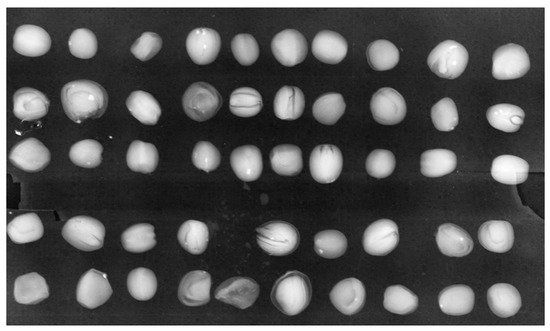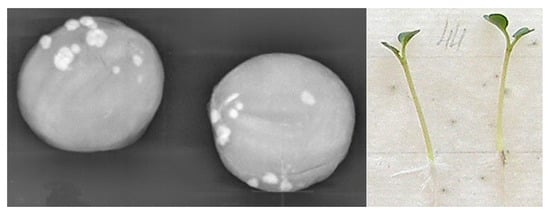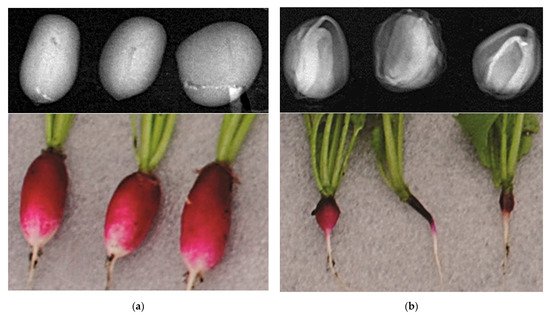You're using an outdated browser. Please upgrade to a modern browser for the best experience.
Please note this is a comparison between Version 1 by Nikolay Priyatkin and Version 3 by Jessie Wu.
This e seeds of cruciferous crops (Brassicaceae family) are high in fat oil (33–40%) and protein (25–36%). They are the main nutrients of the seedntry describes that various radiographic characteristics of seeds using automated digital X-ray image analysis techniques.
- Brassica oleracea L
- radiographic analysis
1. Background
In practice, seed growers constantly have to deal with the heterogeneity of seeds. On the one hand, seed variety, or heterogeneity is a biologically useful phenomenon, developed in the process of evolution, which ensures the stability and reliability of the population, necessary for the survival of species [1][2][2,3]. At the same time, seed variability is often undesirable for the practice of agricultural production. Unevenness of seedlings, different productivity of plants and heterogeneity of products in terms of quality is largely determined by the poor quality of seeds.
Traditional methods of seed quality control are mostly labor-intensive, time-consuming and lead to destruction of the analyzed sample. Modern scientific research enables the use of automated methods of seed quality evaluation, allowing to obtain more information and in a shorter time.
The method of radiography of seeds favorably differs from others simplicity of use, expeditiousness and non-destructive nature, which allows applying other, morphometric methods for the analysis of seeds quality. The method is standardized: ISO 6639/4-87; GOST 28666.4-90; GOST R 59603-2021 [3][4][5][6,7,8].
In recent years, in a joint work of the staff of the Federal Scientific Vegetable Center (FSVC), Agrophysical Research Institute (ARI) and St. Petersburg Electrotechnical University (SPbETU), “Methodological guidelines for radiographic analysis of vegetable crops seed quality” were developed based on a large-scale experiment on the seeds of 25 species of vegetable crops belonging to 10 botanical families [6][7][8][9,10,11].
2. Inspection of Brassica oleracea L., var. Capitata Seeds
The results of radiographic analysis of seeds of eight samples of white cabbage of different origin and production sites, revealed a great heterogeneity of their internal structure, (Figure 1). Even a general glance at the radiograph is able to determine the heterogeneity of seeds. The details of the internal structure of the seeds are differently arranged and give out different drawings in the image.

Figure 1. Radiographic image of Brassica oleracea L., var. capitata seeds.
Analysis of Table 1 allows us to indicate a general tendency of connection between X-ray features and seed viability. It consists in the following: as a rule, seeds, which look uniformly light or with insignificant detailing on the images, sprout well. Basically, the number of normal seeds from the point of view of radiographic analysis coincides with the number of germinated seeds. Seeds from the group “germ partitioning of germ parts with soft partitioning” germinated (Table 1).
Table 1. Comparison of the results of radiographic analysis and laboratory germination of Brassica oleracea L., var. capitata seeds.
| Parameters | Varieties | ||||||
|---|---|---|---|---|---|---|---|
| Amager | Belorusskaya | Moskovskaya Pozdnyaya | Podarok | ||||
| Trait according to the results of radiographic analysis, % | |||||||
| Normal | 45 | ||||||
| Brightness Deviation, brightness units | 41 | 42 | 56 | ||||
| 39 | 42 | 45 | Empty | 0 | 0 | 14 | 0 |
| Germ partitioning of germ parts with soft partitioning | 11 | 8 | 8 | 9 | |||
| Patterned | 17 | 16 | 5 | 22 | |||
| Angulated | 13 | 23 | 22 | 10 | |||
| With irregular shading | 14 | 12 | 9 | 3 | |||
Irregular shading on the projection of seed # 46, confirmed by low values of the indices “average brightness” and “standard deviation of brightness” are also evidence of its non-viability (Figure 5, Table 3).

Figure 5. Radiography of seeds and photograph of Brassica oleracea L., var. capitata seedlings with “irregular shading” trait.
Table 3. Analysis of brightness parameters of digital X-ray images of Brassica oleracea L., var. capitata seeds with the trait “irregular shading”.
| Parameter | Seed ID | |||
|---|---|---|---|---|
| 45 | 46 | 47 | ||
| Average Brightness, brightness units | 165 | 142 | 193 | |
| Brightness Deviation, brightness units | 42 | 35 | 47 | |
| Germination, % | ||||
| Germinated | 54 | 52 | 48 | 62 |
| Sprouting | 16 | 14 | 11 | 18 |
| Not germinated | 30 | 34 | 39 | 20 |
X-ray seed quality indices were established visual analysis of numerous of different varieties of cabbage seeds and their comparison with the results of laboratory germination.
A selection of radiographic images of seeds and photos of sprouts, where the X-ray image of a particular seed and its behavior under conditions favorable for germination are compared.
The obvious separation of the embryo parts and irregular shadows on the projection of seed #1 were reflected in its delayed germination and in the abnormality of the seedling (Figure 2).

Figure 2. Radiography of seeds and photograph of white cabbage sprouts with “separation of embryo parts” clearly visible in seed number 1.
A softer separation of the embryo parts of seed #8 without additional shadows does not lead to a deterioration in the quality of the seedling (Figure 3).

Figure 3. Radiography of seeds and photograph of white cabbage seedlings “soft separation of embryo elements”.
The pronounced “patterning” with deep separation of seed embryo parts and reduced values of the index “average brightness” # 38, 40 indicate their non-viability (Figure 4, Table 2).

Figure4. Radiography of seeds and photograph of white cabbage sprouts with “patterning of internal structure” (seed number 38 and 40 only).
Table 2. Analysis of brightness parameters of digital X-ray images of Brassica oleracea L., var. capitata seeds with the trait “patterning of internal structure”.
| Parameter | Seed ID | ||
|---|---|---|---|
| 38 | 39 | 40 | |
| Average Brightness, brightness units | 162 | 184 | 162 |
Angular shape of a seed in most cases indicates its non-viability (Figure 6). As a result of automatic analysis of digital X-ray images of white cabbage seeds, it was found that the trait “angularity” of the seed can be described by such indicators as roundness and circle factor.

Figure 6. Radiography of seeds and photograph of Brassica oleracea L., var. capitata seedlings with angular seed shape.
In seeds with the trait “angularity” the values of these indicators are significantly lower than in normally formed seeds (Table 4). Seeding qualities of angular seeds in most cases are impaired (Figure 6).
Table 4. Analysis of the shape of digital X-ray images of angular Brassica oleracea L., var. capitata seeds.
| Parameter | Seed ID | ||
|---|---|---|---|
| 14 | 18 | 16 | |
| Roundness, nondimensional value | 0.734 | 0.647 | 0.890 |
| Circle factor, nondimensional value | 0.927 | 0.907 | 0.991 |
Surface mycota of seeds are clearly distinguished on radiographs due to their dense consistency (Figure 7). Although they do not particularly affect seed germination, their negative effect may appear in the further development of the plant.

Figure 7. Radiography of infected seeds and photograph of Brassica oleracea L., var. capitata seedlings.
Thus, the main X-ray traits of cabbage seeds, which can be used to judge about their seeding qualities, were revealed. They are as follows: clear separation of embryo details indicates reduced seed viability (Figure 2). Irregular darkening (Figure 5) in the images also indicates poor seed quality. Expressed “patterning” with deep separation of seed embryo parts (Figure 4) as an indicator of loss or reduction of nutritive tissue, respectively, leads to seed death. The images often show angular seeds (Figure 6). They look as such only on the X-ray images, mainly due to some desiccation of the cotyledons, while outwards they have almost regular round shape. In our experiment, about 75% of such seeds do not germinate. The patterns revealed are probabilistic. Further research is required to find out the reasons for this relationship.
The high information value of the method of seed radiography provides an opportunity for multidimensional analysis. Radiography of seeds as a “non-destructive” method is especially convenient in breeding practice, when working with small lots of breeding or collection material.
3.2. Inspection of Raphanus sativus L., var. Radicula Seeds
Populations and homogeneous radish seeds were analyzed and fully preserved for further work. As a rule, seeds of inbred lines are obtained piecemeal and it is not allowed to waste them for analysis. In such cases, the method of radiography is indispensable, as it provides complete preservation of the analyzed seed sample. Seeds of variety Aria (I0) in the X-ray image (Figure 8a) have low, but sufficiently uniform optical density of projection and during germination gave complete root crops. On the contrary, the internal structure of seeds of inbred generation I3 looks more “patterned,” with pronounced darkening revealing voids and loss of embryo body density (Figure 8b). When germinated, such seeds were unable to form complete root crops, an inbred depression expressed by reproductive dysfunction.

Figure 8. Reproductive dysfunction of Raphanus sativus L., var. radicula plants due to defects in internal seed structure: (a) population seeds (I0) and their complete crop; (b) seeds of inbred line (I3) and unformed product swelling.
